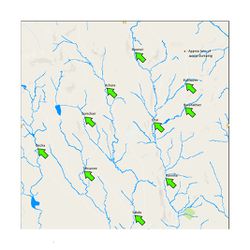Difference between revisions of "ISSS608 2017-18 T3 Assign Chen Fan"
(Created page with "<div style=background:#2B3856 border:#A3BFB1> 250px <font size = 5; color="#FFFFFF">VAST Challenge 2018:Like a Duck to Water</font> </div> <!--MAIN HEA...") |
|||
| Line 43: | Line 43: | ||
<br>Arsenic, Atrazine, Biocarbonates, Cadmium, Chloridinine, Chromium, copper, Dissolved oxygen, fluoranthene, gamma-hexachlorocyclohexane, Methylosmoline, DDD,DDE and DDT, PCB, pentroleum hydrocarbons, Water temperature, Zinc | <br>Arsenic, Atrazine, Biocarbonates, Cadmium, Chloridinine, Chromium, copper, Dissolved oxygen, fluoranthene, gamma-hexachlorocyclohexane, Methylosmoline, DDD,DDE and DDT, PCB, pentroleum hydrocarbons, Water temperature, Zinc | ||
| − | <br><b> What are we trying to solve? </b> | + | <br><b> What are we trying to solve? </b> |
| + | |||
1. By characterizing the past and most recent situation with respect to chemical contamination in the Boonsong Lekagul waterways, find trends of possible interest in this investigation.<br> | 1. By characterizing the past and most recent situation with respect to chemical contamination in the Boonsong Lekagul waterways, find trends of possible interest in this investigation.<br> | ||
Latest revision as of 11:13, 7 July 2018
|
|
|
|
|
To be a Visual Detective
Last year, the Kasios Furniture Company was implicated in environmental damage to the Boonsong Lekagul Wildlife Preserve for both dumping toxic waste and polluting the air with chemicals from its manufacturing process. But Kasios is not taking these accusations lying down, and they deny any accusation of industrial waste dumping! Kasios’ spokespersons state that last year's research shows there isn’t any ground contamination near the remote ranger station and they have inspected that area and found it as pristine as the rest of the preserve. Outraged ornithology professors from Mistford College journeyed out to look over the dumping site themselves and perform soil analyses. They returned to report that the site looked like there had been recent excavation and building activities going on. Boonsong Preserve rangers later confirmed that a new ranger station was being built at that site! Soil samples taken from the site were inconclusive in detecting Methylosmolene (the toxic manufacturing chemical in the suspected dumping) or any other contaminant, as new top soil had been trucked in. With a primary piece of evidence against Kasios now gone, investigators will need to take another approach.
Mini Challenge 2 Background
Professors in the Mistford College Hydrology Department have come forward with several years of water sensor readings from rivers and streams in the preserve. These samples were taken from different locations scattered throughout the area and contain measurements of several chemicals of possible interest, but they have never been analyzed due to lack of funding. Could visual analytics help reveal something in this data that could make up for the soil evidence that was destroyed? Now we are going to investigate the hydrology data from across the Preserve with a map of the Preserve, with named sampling sites indicated on the map and with readings from each sampling station over time for several different chemicals and water properties.
Before we start, what do you need to know?
1. The Reserve Map
This is the waterway of the Preserve, Sampling location has been marked in the map.
2. The Main Chemical Measure
Arsenic, Atrazine, Biocarbonates, Cadmium, Chloridinine, Chromium, copper, Dissolved oxygen, fluoranthene, gamma-hexachlorocyclohexane, Methylosmoline, DDD,DDE and DDT, PCB, pentroleum hydrocarbons, Water temperature, Zinc
What are we trying to solve?
1. By characterizing the past and most recent situation with respect to chemical contamination in the Boonsong Lekagul waterways, find trends of possible interest in this investigation.
2.Finding anomalies in this dataset and for better understanding the comprehensive situation across the Preserve, what changes should make in sampling approach.
3. What concern should we pay attention for the Pipit or other wildlife through the findings and give suggestions to sampling strategy.

